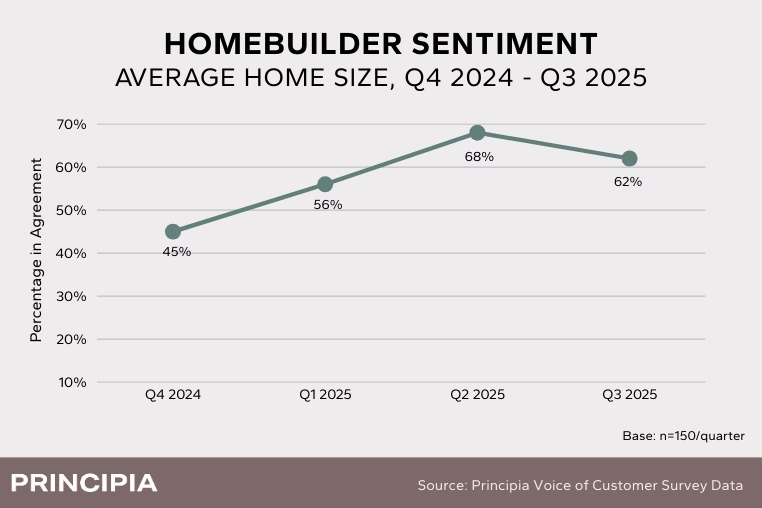Homebuilders Say Home Sizes Are Shrinking— What Could This Mean For Future Demand?
Over the past year, Principia surveyed homebuilders to understand trends in new construction. One key question asked of homebuilders: “Is your average home size smaller than it was 12 months ago?”
Here’s what we found:
- In Q3 2025, agreement dipped slightly to 62%, but that’s still well above levels seen nine months ago
- During the first three quarters of our tracking period, builder agreement with this statement rose from 45% to 68%, signaling a clear shift toward smaller homes

Why Are Homes Getting Smaller?
Several factors may contribute to the decline in the average home size. Understanding these drivers is key to seeing the bigger picture of the housing market.
- A Focus on Efficiency and Sustainability. There is also a growing interest in more efficient and sustainable living. Smaller homes are generally more energy-efficient, requiring less energy to heat and cool. They also have a smaller environmental footprint, which appeals to eco-conscious buyers.
- Affordability Challenges. One of the primary drivers is the ongoing issue of housing affordability. As interest rates and construction costs rise, building and buying large homes has become expensive for many.
- Shifting Buyer Preferences. The demographics and preferences of homebuyers are also changing. Millennials, who now make up a significant portion of the market, often prioritize location and lifestyle over square footage. Many prefer smaller, more manageable homes in walkable neighborhoods with access to amenities.
What This Trend Could Mean for the Future
The trend toward smaller homes has several implications for homebuilders, buyers, manufacturers and the broader real estate market.
- For homebuilders, it means adapting design and construction strategies. The focus will likely shift to creating smarter, more flexible floor plans that make the most of every square foot. Features like multi-functional rooms, built-in storage, and open-concept layouts will become even more important in new construction.
- For buyers, this trend could bring both opportunities and challenges. While smaller homes may be more affordable, buyers will need to be more intentional about their space needs. The trade-off for a lower price point might be less room for a growing family or a dedicated home office.
- For manufacturers, this trend could mean less material per project—and possibly put emphasis on premium finishes and durability to make every square foot count.
Overall, a shrinking average home size reflects a market that is adapting to new economic realities and evolving consumer demands. Possibly signaling a move toward more practical, efficient, and attainable housing for a new generation of homeowners.